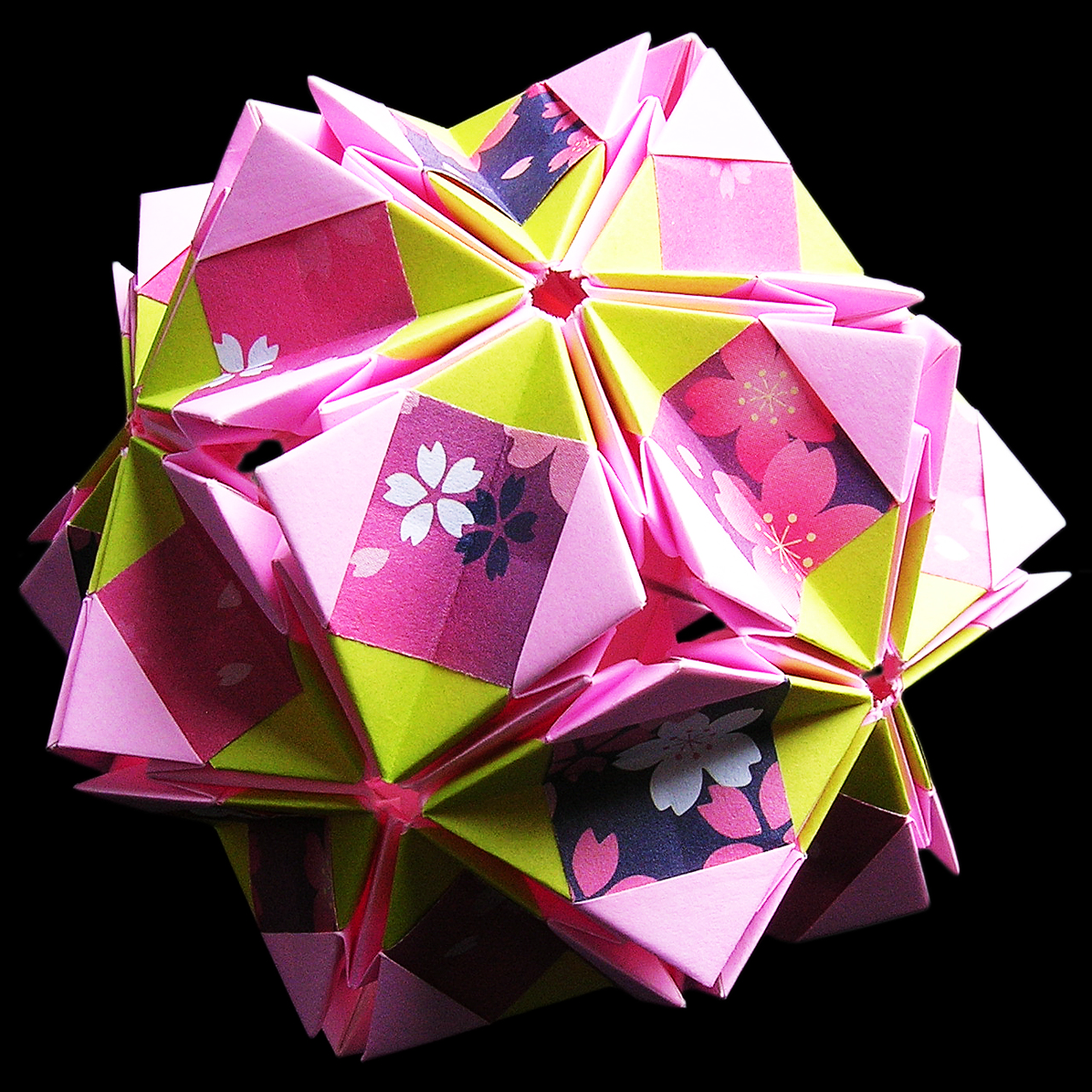
Tarantella Type Flat with Tanzaku
Work Data
Created : Feb. 2011
Drawing : Aug. 2018
Type of Assembling : Modular-type
Joining method : Arabesque-joint
Number of a part : 30, Decoration-part : 30 × 2
Paper size : 7.5cm square, Decoration-part : 3.75cm × 1.875 square
タランテラについて / About Tarantella
This work makes us think about that It’s difficult to judge by only the appearances of works in Modular origami.
The work is Tarantella which is one of Kusudama suites series.
Natural type of the work was created in 2011 and was drawn the diagram in 2018.
I made a few works of Tarantella which were decorated with decoration-part last year.
Natural type can be assembled by paper pieces as a Paper joint type, Flat type is a modular type whose the joining method is Arabesque-joint.
Tarantella Natural type
モジュラー作品を見た目で判断するのは非常に難しいぞな。としみじみ感じさせる「タランテラ」の「フラットタイプ」。
もちろんくすだま組曲シリーズのひとつ。
「ナチュラルタイプ」は2011年創作、2018年作図。昨年デコレーションパーツで飾った作品もいくつか作った。
ナチュラルタイプがジョイニングマテリアル(まとめ材)に紙片を使う「ペーパージョイントタイプ」に対し、こちらはジョイニングマテリアルを一切使用しない生粋の「モジュラータイプ」。ジョイニングメソッド(接合方法)は「アラベスクジョイント」。
4種の仕上がりタイプをもうちょっと詳しく / Detail of four types of completion works
There are four forms of completion works in Kusudama suites series; Natural type, Flat type, Double flat type, and sharp type.
What differences among these works are expressed depending on how to adjust a part at the last process.
It means the whole shape of the works are made by differences of mountain folds and valley folds.
くすだま組曲シリーズの作品は4種類の仕上がりの形がある。
「ナチュラルタイプ」「フラットタイプ」「ダブルフラットタイプ」「シャープタイプ」。
この4種の形の違いは、折り上がったパーツの最後の工程「折り線どおりに形を整える」で、どのように形を整えるか。によって表現される。つまり、山折り線、谷折り線、またはその折り線の有無で表される形。
実際の作品群
正方形はパーツの仕上がりの形の簡素化したもの。
実際、くすだま組曲シリーズのすべての作品において、フラップとポケット部分を除いたボディの部分は 「正方形」 だす。
Even though works have different processes or different joining methods, the overall impressions will be a resemblance if they are in the same type.
作品の折りたたみ工程やジョイニングメソッド(接合方法)が違っても、仕上がりのタイプが同じなら、全体的なフォームは似た印象になる。
っつうか、ナチュラルタイプを見る限り、4つの作品の何が違うのか?
と、詰め寄りたくなるな。
リバースタイプとは何か / What is the reverse type?
Though the diagram of Tarantella has been distributed, why did I introduce it is that it’s the work whose parts of Ländler were assembled in the state of being reversed.
The reverse type in Modular origami is
The works whose parts are turned over and are assembled.
昨年折り図を配布しているにも関わらず、なぜイマサラ 「タランテラ」 なのかというと、実はこの作品は今月 (2019年3月) にパトロンさまに配布している折り図の作品 「レントラー シャープタイプ」 のリバースタイプ。
リバースタイプとは、
折り工程をはじめから終わりまで折り、仕上がったパーツをくるりと裏側にひっくり返して、そのまま組み立てた作品のこと。
裏組み作品。
作品によっては、多少部分的に山折り線、谷折り線が入れかわているものもあったり、ダイナミックにジョイニングメソッドが変わっていたりするものもあるが、まぁ、だいたいそんなやうな感じ。
リバースタイプをもうちょっと深く
くすだま組曲シリーズ作品では、すべての作品にリバースタイプは存在する。
ただし、同じジョイニングメソッドが使えるか。というと、そうでもない。
表タイプで使ったジョイニングメソッドが、裏タイプでは働かない。なんていうこともよくある。
もっと言えば、表タイプは「モジュラータイプ(接着剤不要)」なのに、裏タイプは「貼り合わせタイプ(接着剤が必要)」。という作品も、ありうる。
そして、私の場合、
やっぱりモジュラータイプにこだわる → ジョイント部分をグリグリいじる → ボディもネチネチいじる → オリジナルとさっぱりかけ離れる → あたらしい作品誕生!!
なんてな。
「ポルスカ」 はそうやって生まれた作品だったりな。
作品を2倍楽しむ方法 / Enjoy more
This work “Tarantella flat type” hasn’t been written the diagram yet.
But works of “Ländler sharp type” and “Tarantella natural type” have the diagrams.
You can make Tarantella flat type by referring to these diagrams.
Also, enjoy works by comparing how different they are.
この 「タランテラ フラットタイプ」 の折り図はまだない。
しかし、「タランテラ ナチュラルタイプ」 と 「レントラー シャープタイプ」 の折り図はある。
これらの折り図を参照すれば、きっとこのタランテラ フラットタイプは作れる。
はず。
ぜひ、チャレンジしてくりゃれ。
